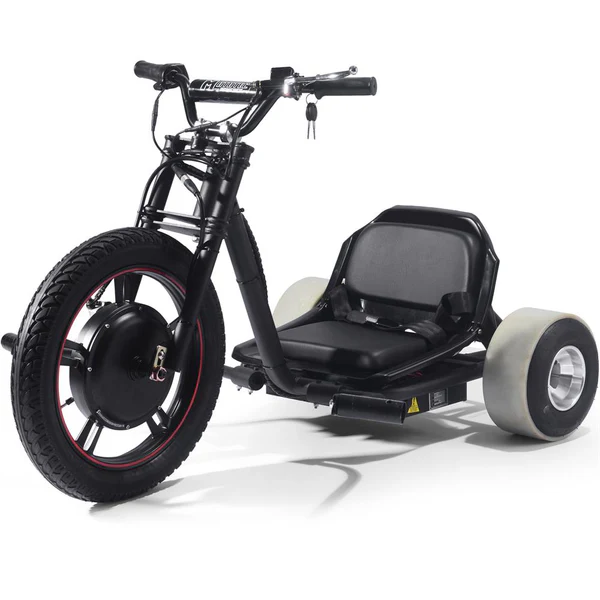Regarding drift trikes, the frame is a crucial component that can significantly impact the vehicle’s overall performance. A well-designed drift trike frame can enhance stability, control, and maneuverability, ultimately creating a more exhilarating riding experience. This blog post will delve into the importance of a proper drift-trike frame and how it can make a difference in your trike-drifting adventures.
Understanding the Basics of a Drift-Trike Frame
At its core, a drift-trike frame is the vehicle’s skeleton, providing a crucial platform for mounting all the other components necessary for a fully functional trike. This framework is not just about holding pieces together but fundamentally shaping the trike’s performance characteristics. The design and integrity of the frame influence how well the trike can navigate turns, maintain stability during high-speed drifts, and absorb impacts from uneven terrain.
A key aspect of understanding drift-trike frames lies in recognizing the impact of weight distribution. The frame’s layout affects how the weight of the rider and the trike itself are spread across the three wheels. This balance is pivotal for achieving the desired drifting action, as it affects the ease with which the trike can slide around corners while maintaining enough grip to control the drift. Additionally, the frame’s configuration plays a vital role in accommodating riders of different sizes, ensuring that everyone can enjoy a comfortable and controlled ride.
The selection of materials used in the frame’s construction also deserves attention. Choices range from lightweight alloys, which offer a blend of strength and agility, to more durable metals that can withstand the rigours of aggressive riding. The decision on material affects not just the performance but also the longevity of the drift trike, making it a key consideration for any rider looking to invest in their drifting experience.
The Role of Frame Geometry in Drift Performance
The geometry of a drift-trike frame is a pivotal element that directly influences how the vehicle maneuvers and responds during a drift. Key components such as the angle of the head tube, which affects steering sensitivity and response, the length of the wheelbase, determining stability at various speeds, and the height of the seat, impacting the rider’s centre of gravity, all intertwine to dictate the drift-trike’s handling characteristics.
A frame designed with optimal geometry allows for smoother initiation of drifts, providing riders with the confidence to execute tight turns and maintain control throughout a slide. It also ensures seamless transitions between drifting and straight-line riding, enhancing the overall riding experience. Adjustments in frame geometry can fine-tune the drift trike’s behavior, making it either more agile for quick, sharp turns or more stable for high-speed drifting.
This adaptability allows riders to customize their trike’s performance based on their riding style or the demands of specific tracks or terrains. Whether you’re a novice seeking a forgiving setup encouraging skill development or an experienced drifter aiming for precision and agility, understanding and selecting the right frame geometry is crucial. It’s not merely about the physical shape but how that shape enables the drift trike to move with the rider, creating a symbiosis between humans and machines that elevates the drifting experience.
Material Matters: Choosing the Right Frame Composition
The selection of materials for a drift-trike frame goes beyond mere aesthetics; it directly impacts the trike’s performance, handling, and durability. Aluminum, renowned for its lightness, offers a drift trike responsiveness and agility, enabling easier handling and quicker direction changes. This material primarily benefits those seeking speed and maneuverability in their drifts. On the other end of the spectrum, with its inherent strength and resilience, steel provides a frame that can endure more rigorous use and harsher terrains.
Steel frames are appreciated for absorbing vibrations, offering a smoother ride over bumpy surfaces and lending a feeling of stability and control at higher speeds. Composite materials, such as carbon fibre, represent a newer class of options that combine light weight with exceptional strength, though at a higher cost.
Riders looking to push the boundaries of drift tricking might find the investment in carbon fibre frames worthwhile for their unmatched blend of durability and performance enhancement. When deciding on the frame material, riders should weigh the benefits of each in terms of their riding style, preferred terrain, and performance goals. Whether prioritizing speed, stability, or a balance of both, the choice of frame material is a foundational decision that shapes the drift trike’s character and capabilities.
How to Choose the Right Frame Drift Trike for Your Riding Style?
Choosing the right frame drift trike for your riding style involves a series of considerations that can influence your comfort, performance, and overall enjoyment. Here are five essential points to guide you in selecting a frame that aligns with your unique preferences:
Identify Your Riding Environment
Your primary riding terrain—be it smooth asphalt tracks or rough, undulating paths—will dictate the type of frame that best suits your needs. For instance, a frame with integrated suspension might be more appropriate for rougher terrains to absorb shocks and provide a smoother ride.
Consider Your Riding Style
Are you into high-speed drifting or prefer technical riding involving intricate maneuvers? Your style will influence the frame geometry that best supports your activities, with more aggressive angles suiting high-speed drifts and a more balanced geometry favoring technical precision.
Assess Maneuverability vs. Stability
Some riders prioritize quick and agile movements, while others may value stability, especially at high speeds. A shorter wheelbase can offer more maneuverability, whereas a more extended wheelbase provides better stability.
Weight and Material
The frame’s weight, influenced by its material, can significantly affect your trike’s handling. Lighter materials like aluminum are more maneuverable, which might be preferred for riders focusing on agility and speed.
Customization Options
Consider how much customization you desire. A custom frame allows for personalization to your body measurements and riding preferences, while pre-fabricated frames may offer convenience and immediate availability.
By contemplating these factors, you can make a more informed decision that enhances your drifting experience and aligns with your riding style.
Custom vs. Pre-fabricated Drift-Trike Frames
Deciding between a custom and a pre-fabricated drift-trike frame involves weighing personalization against convenience and cost. Custom frames provide a unique opportunity to tailor every aspect of the trike’s design to an individual’s preferences and riding requirements. This means everything from specific frame dimensions that fit a rider’s body perfectly to incorporating specialized features that cater to particular styles of drifting or handling preferences. Such customization can optimize performance and comfort, offering a personalized tricking experience. On the other hand, pre-fabricated frames offer a quick and often more economical route to getting on the track.
With a wide variety of designs available, many riders find pre-fabricated options that suit their needs without the wait or expense of custom fabrication. These frames benefit from the manufacturer’s experience and research into drift-trike performance, providing a reliable and tested solution that can appeal to both beginners and seasoned drifters alike. Choosing between the two ultimately depends on a rider’s priorities, budget, and specific needs. While the allure of a custom frame’s perfect fit and personalized features is strong, the accessibility and immediate satisfaction of selecting a pre-fabricated frame hold considerable appeal for many in the drifting community.
Innovations in Drift-Trike Frame Design
The drift-tricking world has seen remarkable frame design advancements, reflecting a commitment to evolving rider needs and technological progress. Innovators have introduced adjustable frame components, allowing riders to modify their trike’s geometry on the fly. This flexibility enables a custom fit for different body sizes and adjustments for varied riding styles or conditions, enhancing comfort and performance. Another leap forward has been the incorporation of integrated suspension systems.
Once reserved for high-end bicycles and motorcycles, these systems have been adapted to drift trikes, offering improved ride quality and increased control over uneven surfaces. This innovation elevates the rider’s experience and expands the terrains suitable for drift tricking from smooth asphalt to more challenging, undulating paths.
Material science has also played a pivotal role in frame innovations, introducing new alloys and composite materials that offer an unprecedented balance of strength and lightness. Such materials enable the creation of durable frames capable of withstanding the rigours of drift tricking but also significantly lighter for nimble handling and enhanced maneuverability. These advancements reflect a broader trend towards customization and personalization within the drift trike community, with frame designs that cater to a wide range of preferences and riding scenarios.
Maintenance Tips for Your Drift-Trike Frame
Maintaining your drift-trike frame is crucial for preserving its functionality and extending lifespan. Regular inspections are vital; look for any signs of structural damage, such as cracks or bends that could compromise the integrity and safety of the frame. Pay special attention to welds and joints, which are common areas for stress and potential failure.
Keeping the frame clean from dirt and debris maintains its appearance and prevents the build-up of materials that could hide or cause damage. Lubricating moving parts associated with the frame, like bearings and joints, ensures smooth operation and prevents premature wear. Tightening bolts and screws is another crucial step, as vibrations from riding can loosen these components over time, leading to instability or parts coming apart during a ride.
It’s also a good idea to check the alignment of the frame periodically, as impacts from riding can alter the geometry, affecting performance and handling. For those looking to maintain their drift trike’s frame, investing in a basic set of tools and learning how to perform these maintenance tasks can be a rewarding and cost-effective strategy. This ensures that the drift trike remains safe and enjoyable to ride.
Conclusion
Selecting the right drift trike frame is more than just a matter of aesthetics; it’s a foundational decision that influences every aspect of your riding experience. From stability and maneuverability to the ability to withstand the rigours of aggressive drifting, the frame you choose sets the tone for your adventures on three wheels. Embracing the nuances of frame design—the geometry that dictates handling characteristics or the materials that balance durability and lightness—can unlock new levels of performance and enjoyment. As the drift trike community continues to evolve, so do the opportunities for customization and optimization, allowing riders to fine-tune their machines to their precise preferences and styles.
FAQs
Q: What are the key considerations when selecting a frame drift trike?
A: Regarding frame drift trike, the primary factors include the frame’s geometry, material, and the rider’s style and preferences. The geometry affects handling and stability, while the material impacts the trike’s weight and durability. Your style and where you plan to ride (smooth versus rough terrain) should guide your choice to ensure the best balance between speed, agility, and comfort.
Q: Can changing the frame material affect the drift trike’s performance?
A: Absolutely. The choice of frame material, such as aluminum for its lightness and agility or steel for its durability and shock absorption, plays a significant role in the drift trike’s performance. The suitable material can enhance maneuverability, speed, and the overall riding experience depending on the terrain and riding style.
Q: Is it worth investing in a custom drift-trike frame?
A: This depends on your specific needs and budget. Custom frames offer tailored specifications for your body size, riding style, and performance requirements, providing a personalized experience. However, pre-fabricated frames are also designed to meet high-performance standards and can be more cost-effective, balancing quality and convenience for many riders.
| Related Business Listings |
| Contact Directory |
| Local Business Profiles |



